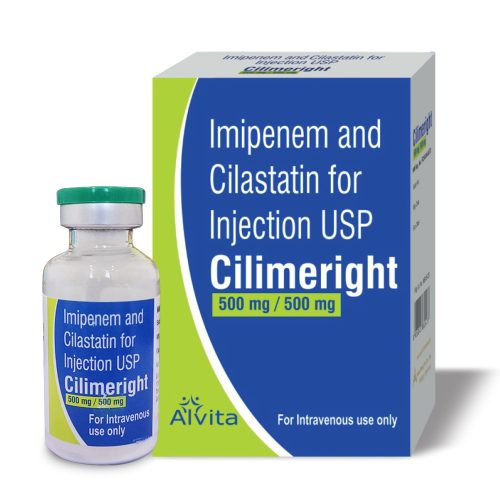
Cilimeright 500mg/500mg injection
Therapeutic Class
Carbapenem
Indications
IMIPENEM AND CILASTATIN FOR INJECT|ON is indicated for the treatment of serious infections caused by susceptible strains of the designated microorganisms in the conditions listed below: Lower respiratory tract infections. Urinary tract infections I ntra-abdominal infections. Gynemlogic infections. Bacterial septicemia. Bone and joint infections. Skin and skin structure infections. Endocarditis. Polymicrobic infections.
Chemical Composition
Each vial contains: Sterile lmipenem U.S.P equivalent to Anhydrous lmipenem 500 mg
Sterile Cilastatin Sodium U.S.P equivalent to Cilastatin 500 mg
Sodium bicarbonate USP added as buffer
Packaging
1’s vial/ pack
Dosage & Administration
Adults The dosage recommendations for IMIPENEM AND CILASTATIN FOR INJECTION represent the quantity of imipenem to be administered. An equivalent amount of cilastatin is also present in the solution. Each 125 mg, 250 mg, or 500 mg dose should be given by intravenous administration over 20 to 30 minutes. Each 750 mg or 1000 mg dose should be infused over40 to 60 minutes. ln patients who develop nausea during the infusion, the rate of infusion may be slowed. The total daily dosage for IMIPENEM AND CILASTATIN FOR INJECTION should be based on the type or severity of infection and given in equally divided doses based on consideration of degree of susceptibility of the pathogen(s), renal function, and bodyweight. Adult patients with impaired renal function, as judged by creatinine clearance < 70 ml/min/1.73 m", require adjustment of dosage as described below. Intravenous Dosage Schedule for Adults with Normal Renal Function and Bodyweight > 70 kg Dosage regimens in column A of Table I are recommended for infections caused by fully susceptible organisms which represent the majority of pathogenic species. Dosage regimens in column B of Table I are recommended for infections caused by organisms with moderate susceptibility to imipenem, primarily some strains of P aeruginosa.
Contraindications
Hypersensitivity to this product.
Warning & Precautions
Warnings; Serious and occasionally fatal hypersensitivity (anaphylactic) reactions have been reported in patients receiving therapy with beta-lactams. these reactions are more apt to occur in person with a history of sensitivity to multiple allergens. There have been reports of patients with a history of penicillin hypersensitivity who have experienced severe hypersensitivity reactions when treated with another beta-lactam. before initiating therapy with IMIPENEM AND CILASTATIN FOR INJECTION, careful inquiry should be made concerning previous hypersensitivity reactions to penicillins, cephalosporins, other beta-lactams, and other allergens. if an allergic reaction occurs, IMIPENEM AND CILASTATIN FOR INJECTION should be discontinued. Precautions: lmipenem and Cilastatin for injection is not indicated in patients with meningitis because safety and efficacy have not been established. infections resistant to other antibiotics for example Cephalosporins, penicillin, and aminoglycosides have been shown to respond to treatment with IMIPENEMAND CILASTATIN FOR INJECTION. CNS adverse experiences such as confessional states, myoclonic activity, and seizures have been reported during treatment with IMIPENEMAND CILASTATIN FOR INJECTION, especially when recommended dosages were exceeded. These experiences have occurred most commonly in patients with CNS disorders (e.9., brain lesions or history of seizures) and/or compromised renal function. However, there have been reports of CNS adverse experiences in patients who had no recognized or documented underlying CNS disorder or compromised renal function. Patients with creatinine clearances of s 5 ml/min/1.73 m, should not receive IMIPENEM AND CILASTATIN FOR INJECTION unless hemodialysis is instituted within 48 hours. For patients on hemodialysis, IMIPENEM AND CILASTATIN FOR INJECTTION is recommended only when the benefit outweighs the potential risk of seizures. Close adherence to the recommended dosage and dosage schedules is urged, especially in patients with known factors that predispose to convulsive activity. Anticonvulsant therapy should be continued in patients with known seizure disorders. lf focal tremors, myoclonus, or seizures occur, patients should be evaluated neurologically, placed on anticonvulsant therapy if not already instituted, and the dosage of IMIPENEM AND CILASTATIN FOR INJECTION reexamined to determine whether it should be decreased or the antibiotic discontinued. As with other antibiotics, prolonged use of IMIPENEM AND CILASTATIN FOR INJECTION may result in overgrowth of no susceptible organisms. Repeated evaluation of the patient's condition is essential. lf superinfection occurs during therapy, appropriate measures should be taken.
Side Effects
IMIPENEM AND CILASTATIN FOR INJECTION' is generally well tolerated. Side effects rarely require cessation of therapy and are generally mild and transient; serious side effects are rare. Local reactions: erythema, local pain and induration, thrombophlebitis. Allergic: rash, pruritus. urticaria. erythema multiforme, Stevens-Johnson syndrome, angioedema, toxic epidermal necrolysis (rarely), exfoliative dermatitis, (rarely) candidiasis, fever including drug fever, anaphylactic reactions. Gastrointestinal: nausea, vomiting, diarrhoea, staining of teeth and/or tongue. Pseudomembranous colitis has been reported. Blood: eosinophilia, leucopenia, neutropenia including agranulocytosis, thrombocytopenia, thrombocytosis, decreased hemoglobin and prolonged prothrombin time. A positive direct Coombs test may develop. Liver function: mild increases in serum transaminases, bilirubin and/or serum alkaline phosphatase, hepatitis rarely has been reported. Renal function: oliguria/anuria, polyuria, acute renal failure (rarely). The role of 'IMIPENEM AND CILASTATIN FOR INJECTION' in changes in renal function is difficult to assess, since factors predisposing to prerenal uraemia or to impaired renal function usually have been present. Elevated serum creatinine and blood urea have been seen. A harmless urine discoloration, not to be confused with haematuria, has been seen in children. Central nervous system: myoclonic activity, psychic disturbances including hallucinations, paraesthesia, confusional states or convulsions have been reported. Granulocytopenic patients: drug-related nausea and/or vomiting appear to occur more frequently in granulocytopenic patients than in non-granulocytopenic patients treated with ‘IMIPENEM AND CILASTATIN FOR INJECTION'. Special senses: hearing loss, taste persuasion. Other reported reactions with an unknown causal relationship Gastrointestinal: hemorrhagic colitis, gastroentedtis, abdominal pain, glossitis, tongue papillar hypertrophy, heartburn, pharyngeal pain, increased salivation. Central nervous system: dizziness, somnolence, encephalopathy, vertigo, headache. Special senses: tinnitus. Respiratory: chest discomfort, dyspnoea, hyperuentilation, thoracic spine pain. Cardiovascular: hypotension, palpitations, tachycardia. Skin: flushing, cyanosis, hyperhidrosis, skin texture changes, pruritus vulvae. Body as a whole: polyarthralgia, asthenia/weakness. Blood: haemolytic anaemia, pancytopenia, bone marrow depression.
Drug Interaction
Generalized seizures have been reported in patients who received ganciclovir and IMIPENEM AND CILASTATIN FOR INJECTION. These drugs should not be used concomitantly unless the potential benefits outweigh the risks since ionmmitant administration of IMIPENEM AND CILASTATTN FOR injection and probenecid results in only minimal increases in plasma levels of imipenem and plasma halilife, it is not recommended that probenecid be given with IMIPENEI\4 AND CILASTATIN FOR INJECTION,IMIPENEM AND CILASTATIN FOR INJECTION should not be mixed with or physically added to other antibiotics. However, IMIPENEM AND CILASTATIN FOR INJECTION may be administered concomitantly with other antibiotics, such as aminoglycosides.

